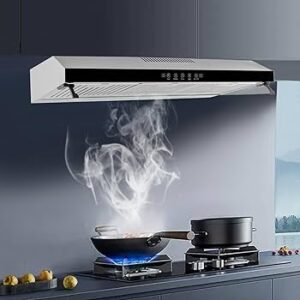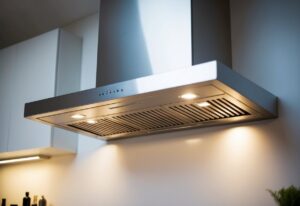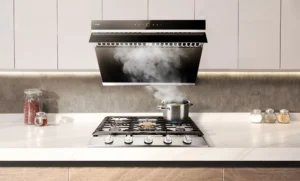Ever finished cooking dinner only to realize the smell of last night’s fried fish still lingers in your kitchen? Or noticed a thin, greasy film forming on your cabinets over time? If you’ve ever asked yourself, “Do I need a range hood?” then you’re not alone.
Many homeowners underestimate just how much of a difference proper kitchen ventilation makes. A range hood might seem like just another fancy kitchen add-on, but in reality, it plays a powerful role in keeping your air clean, your kitchen fresh, and your home comfortable.
Whether you’re remodeling your kitchen or just tired of battling smoke and lingering odors, understanding why (and when) you need a range hood could change the way you cook forever.
What a Range Hood Does

A range hood, sometimes called a vent hood or exhaust hood, is an essential kitchen appliance that sits above your stove or cooktop. Its main purpose is to improve air quality in your kitchen while cooking. Here’s a detailed breakdown of how it works and why it’s important:
- Removes Smoke and Odors
When you cook, especially frying or sautéing, smoke and strong odors are released into the air. The range hood draws these fumes up and away from your kitchen, helping to prevent lingering smells and keeping the kitchen more pleasant. - Reduces Heat and Steam
Cooking generates heat and steam, which can make your kitchen uncomfortable and even affect nearby cabinets or walls over time. A range hood helps pull this excess heat and moisture away, keeping your kitchen cooler and protecting surfaces from damage. - Filters Grease and Particles
Many range hoods have grease filters that trap tiny oil particles released during cooking. This prevents grease from settling on your walls, ceiling, and appliances, reducing cleaning effort and minimizing fire hazards. - Improves Indoor Air Quality
By venting smoke, odors, and airborne particles, range hoods help reduce indoor air pollutants like carbon monoxide, nitrogen dioxide, and volatile organic compounds (VOCs), which are released during cooking. This is especially important in kitchens that are part of open-plan living spaces. - Lighting Your Cooking Area
Most range hoods come with built-in lights that illuminate the cooktop, making it easier to see what you’re cooking and ensuring safer food preparation. - Optional Venting to the Outside or Recirculation
- Ducted hoods: These vent air outside your home, which is very effective at removing smoke and odors.
- Ductless/recirculating hoods: These filter the air and then release it back into the kitchen. They are less effective than ducted hoods but easier to install.
A range hood acts as a combination of an air purifier, fan, and light for your kitchen. It keeps the air clean, reduces grease buildup, manages heat and steam, and improves the overall cooking environment. Without one, kitchens can quickly become smoky, greasy, and uncomfortable.
Factors to Consider Before Getting a Range Hood
Choosing the right range hood goes beyond picking a stylish model that matches your kitchen. A good range hood improves air quality, keeps your kitchen safe, and enhances cooking comfort. Below are the key factors to consider in detail:
- Type of Range Hood
There are several types of range hoods, and the type you choose affects performance, installation, and cost:
- Ducted (vented) hoods: These vent air directly outside your home. They are highly effective at removing smoke, steam, odors, and heat. However, they require proper ductwork, which can be expensive or difficult to install in some kitchens.
- Ductless (recirculating) hoods: These filter the air and release it back into the kitchen. They are easier to install and more flexible in terms of placement, but they are generally less efficient at removing odors and moisture.
- Under-cabinet, wall-mounted, and island hoods: The installation type depends on your kitchen layout and the location of your cooktop. Island hoods are designed for cooktops in the center of the kitchen, while under-cabinet hoods are common for standard countertop arrangements.
- Size and Coverage
The hood should match your stove size to maximize efficiency:
- A range hood should be at least as wide as your cooktop and ideally extend a few inches beyond it.
- Standard stove widths are 30 inches or 36 inches, and hoods typically come in these sizes.
- Proper coverage ensures smoke and steam are captured rather than escaping into your kitchen.
- Ventilation Power (CFM Rating)
CFM, or cubic feet per minute, measures how much air a hood can move. Higher CFM means more powerful ventilation:
- Light cooking (boiling, simmering) may only need 200–400 CFM.
- Medium cooking (frying, sautéing) might require 400–600 CFM.
- Heavy cooking (frequent frying, high-heat cooking) should aim for 600–1,000+ CFM.
Choosing the right CFM ensures smoke and odors are removed efficiently without overloading your kitchen’s airflow.
- Noise Level (Sone Rating)
Range hoods vary in noise levels, measured in sones. A quieter hood makes your kitchen more comfortable, especially if you spend a lot of time cooking or entertaining:
- 1–3 sones: Very quiet, similar to a whisper.
- 3–6 sones: Moderate noise, like a conversation.
- 6+ sones: Loud, may be distracting.
Look for a hood that balances power and noise for your kitchen environment.
- Filter Type and Maintenance
Filters trap grease, smoke, and odors. The type you choose affects cleaning and long-term efficiency:
- Aluminum mesh or stainless steel filters: Capture grease well and are dishwasher-safe.
- Charcoal filters: Needed for ductless hoods to remove odors.
- Frequent maintenance and cleaning are essential to prevent grease buildup and maintain airflow.
- Height and Installation Considerations
The height of the range hood above your stove impacts performance:
- Most hoods are installed 24–30 inches above electric cooktops and 27–30 inches above gas cooktops.
- Too high reduces efficiency; too low may interfere with cooking and increase heat exposure.
- Consider ceiling height, cabinet placement, and surrounding kitchen layout before purchasing.
- Energy Efficiency
Modern range hoods often have energy-efficient fans and LED lights, which reduce electricity consumption. Choosing an energy-efficient model saves money and is better for the environment over time.
- Aesthetic and Design
While performance is key, style matters too:
- Hoods come in stainless steel, black, white, glass, and custom finishes.
- Consider whether you want it to blend in with your cabinets or act as a focal point in your kitchen.
- Additional Features
Some hoods offer features that enhance convenience:
- Multiple fan speeds: Adjust power depending on cooking intensity.
- Automatic sensors: Detect heat or smoke and adjust fan speed automatically.
- Built-in lighting: Provides bright, focused light for cooking.
- Smart connectivity: Control through apps or integrate with smart home systems.
Choosing the right range hood requires balancing power, size, noise, ventilation type, maintenance, and style. Taking all these factors into account ensures you get a hood that keeps your kitchen clean, comfortable, and safe, while matching your cooking habits and kitchen design.
Types of Range Hoods
Range hoods come in different designs and configurations, each suited for specific kitchen layouts, ventilation needs, and aesthetic preferences. Understanding the main types can help you choose the best one for your space.
Under-Cabinet Range Hoods
These are mounted directly under kitchen cabinets above your stove.
- Pros:
- Saves space and blends well with cabinetry.
- Usually less expensive and easy to install.
- Cons:
- Limited design options.
- May not be as powerful as larger hoods.
- Best For: Standard kitchens with cabinets above the stove.
Wall-Mounted Range Hoods
- Description: These attach directly to the wall and extend above the stove. Often have a chimney-style vent.
- Pros:
- Offers strong ventilation performance.
- Can be a stylish focal point in the kitchen.
- Cons:
- Requires wall space and proper venting.
- Usually more expensive than under-cabinet hoods.
- Best For: Kitchens where the stove is against a wall and you want a prominent design element.
Island Range Hoods
Designed for stoves placed on kitchen islands, these hoods hang from the ceiling directly above the cooktop.
- Pros:
- High ventilation power.
- Can serve as a statement piece in open-concept kitchens.
- Cons:
- Typically expensive and requires professional installation.
- Needs ceiling ductwork.
- Best For: Open kitchens with island cooktops that need efficient ventilation and style.
Downdraft Range Hoods
Instead of venting upward, these hoods pull air downward and out through ducts beneath the floor or cabinetry.
- Pros:
- Sleek, hidden design.
- Good for kitchen islands with low ceilings.
- Cons:
- Less effective at capturing smoke compared to traditional hoods.
- More expensive and complex to install.
- Best For: Modern kitchens with limited overhead space.
Ductless / Recirculating Range Hoods
These hoods filter air using charcoal or grease filters and recirculate it back into the kitchen.
- Pros:
- Easy to install—no ductwork required.
- Flexible placement options.
- Cons:
- Less effective at removing heat and moisture.
- Filters need frequent replacement for optimal performance.
- Best For: Apartments, condos, or kitchens where venting outside is not possible.
Convertible Range Hoods
These hoods can function as either ducted or ductless, depending on your kitchen setup.
- Pros:
- Offers flexibility for future changes.
- Can adapt to different installation needs.
- Cons:
- May cost more than standard hoods.
- Slightly less efficient than dedicated ducted hoods.
- Best For: Homeowners who want flexibility and may remodel their kitchen in the future.
Choosing the right type of range hood depends on your kitchen layout, cooking habits, and aesthetic preferences. Under-cabinet and wall-mounted hoods are most common for standard kitchens, while island and downdraft hoods cater to open layouts or unique setups. Ductless and convertible options provide flexibility when external venting isn’t possible.
Benefits of Having a Range Hood

A range hood isn’t just a kitchen accessory—it’s a practical appliance that improves your cooking experience, protects your kitchen, and promotes healthier indoor air. Below is why having one is beneficial:
- Removes Smoke, Odors, and Steam
Cooking produces smoke, strong odors, and steam, especially when frying, grilling, or boiling. A range hood effectively draws these away from your kitchen, preventing lingering smells and keeping your space fresh. This also ensures that your home’s living areas don’t get filled with cooking odors.
- Reduces Grease Buildup
Range hoods trap grease particles released during cooking. Without a hood, grease can settle on walls, cabinets, and countertops, making cleaning more difficult and potentially damaging surfaces over time. A good hood minimizes this problem and keeps your kitchen cleaner.
- Improves Indoor Air Quality
Cooking can release harmful pollutants such as carbon monoxide, nitrogen dioxide, and volatile organic compounds (VOCs). A range hood helps ventilate these pollutants out of your kitchen, reducing respiratory risks and improving overall indoor air quality.
- Controls Kitchen Heat and Humidity
Stove heat and steam can make your kitchen uncomfortable, particularly in small or poorly ventilated spaces. Range hoods remove excess heat and moisture, keeping the cooking area cooler and more comfortable.
- Enhances Lighting Over the Cooktop
Most range hoods come with built-in lights that illuminate the cooking surface. This improves visibility while cooking, making it easier to monitor food and ensuring safer preparation.
- Reduces Fire Risk
Grease and smoke buildup can increase the risk of kitchen fires. By capturing grease particles and venting hot air away from the stove, a range hood can help reduce this risk.
- Adds Style and Aesthetic Appeal
Modern range hoods come in a variety of designs—stainless steel, glass, or custom finishes. They can complement your kitchen décor, serve as a focal point, and add a professional, polished look to your cooking space.
- Protects Your Kitchen Over Time
By removing moisture, grease, and pollutants, range hoods help preserve cabinets, walls, ceilings, and appliances. This reduces wear and tear and can extend the lifespan of your kitchen surfaces.
A range hood is more than a vent—it keeps your kitchen cleaner, healthier, and safer while improving comfort and style. It’s an investment that benefits both your cooking environment and the longevity of your kitchen.
Situations Where You Might Not Need One
While range hoods are very useful, they aren’t always necessary for every kitchen. Certain situations make a range hood less critical, depending on cooking habits, kitchen layout, and ventilation alternatives.
- Minimal Cooking or Low-Smoke Cooking
- If you rarely cook, or your cooking mostly involves low-heat methods like boiling or steaming, a range hood may not be essential.
- Dishes that don’t produce much smoke, grease, or strong odors won’t significantly affect your kitchen air.
- Well-Ventilated Kitchens
- Kitchens with large windows, doors, or cross-ventilation may naturally disperse smoke, steam, and odors without the need for a hood.
- If fresh air flows easily and regularly, you may manage cooking fumes without extra ventilation.
- Electric Cooktops Instead of Gas
- Gas stoves release combustion byproducts like carbon monoxide and nitrogen dioxide, making ventilation more important.
- Electric stoves produce less heat, smoke, and airborne particles, so some homeowners find a hood less necessary.
- Small Cooking Spaces in Temporary or Rental Kitchens
- In small kitchens or rental units where installation of a ducted range hood is impractical, homeowners may rely on portable fans, window vents, or recirculating hoods.
- In these cases, the cost and effort of installing a full hood may outweigh the benefits.
- Limited Budget or Low Priority
- Some homeowners prioritize other kitchen upgrades over a range hood, especially if their cooking style doesn’t produce much smoke or grease.
- In such cases, alternative solutions like opening windows or using portable ventilation fans can suffice.
- Alternative Ventilation Systems
- Homes with central ventilation or high-quality air purifiers may manage smoke and odors effectively without a dedicated hood.
- Advanced HVAC systems with kitchen exhaust ducts can sometimes replace the need for a traditional range hood.
You might not need a range hood if your cooking is light, your kitchen is naturally well-ventilated, you use an electric stove, or alternative ventilation methods are already in place. However, for frequent cooking, frying, or using gas stoves, a range hood remains highly recommended to protect air quality, reduce grease, and maintain comfort.
Maintenance Considerations

A range hood is only as effective as its upkeep. Regular maintenance ensures it performs efficiently, lasts longer, and keeps your kitchen clean. Here’s what to consider:
- Cleaning Grease Filters
- Why it matters: Grease filters trap oil and food particles. Over time, they get clogged, reducing airflow and performance.
- How to maintain:
- Metal mesh or stainless-steel filters can usually be soaked in warm, soapy water or cleaned in the dishwasher.
- Frequency depends on cooking habits—typically once a month for regular cooks.
- Tip: Avoid letting grease build up too long, as it can become a fire hazard.
- Replacing Charcoal or Carbon Filters
- Why it matters: Ductless or recirculating hoods rely on charcoal filters to remove odors.
- How to maintain:
- Charcoal filters are not washable and need replacement every 3–6 months, depending on usage.
- Check manufacturer recommendations for filter type and replacement intervals.
- Cleaning the Exterior
- Why it matters: Cooking splatters and grease can accumulate on the hood’s exterior, dulling its finish and spreading odors.
- How to maintain:
- Wipe the hood with a mild detergent or degreaser and a soft cloth weekly.
- Avoid abrasive cleaners that may scratch stainless steel or painted surfaces.
- Checking and Cleaning the Vent/Ductwork
- Why it matters: For ducted hoods, grease and dust can accumulate in the vent, reducing efficiency and creating fire risks.
- How to maintain:
- Inspect ductwork annually.
- Clean vents using a long brush or hire a professional for thorough cleaning if needed.
- Maintaining Fan and Motor
- Why it matters: A clogged or worn-out fan reduces suction power and increases noise.
- How to maintain:
- Remove and clean the fan blades periodically, following manufacturer instructions.
- Check for unusual noises or vibrations that may indicate the motor needs attention.
- Replacing Lights
- Many hoods come with built-in LED or halogen lights.
- Replace burnt-out bulbs promptly to maintain proper lighting over the cooktop.
- Ensure replacement bulbs match the manufacturer’s specifications.
- Regular Performance Checks
- Why it matters: Over time, the hood may lose efficiency.
- How to maintain:
- Test suction regularly by holding a small piece of paper near the vent—if it doesn’t hold, filters or ducts may need cleaning.
- Address any unusual sounds or reduced airflow immediately to avoid bigger issues.
Proper maintenance of your range hood—cleaning filters, checking ducts, wiping surfaces, and monitoring performance—ensures it works effectively, lasts longer, and keeps your kitchen safe and comfortable. Regular care prevents grease buildup, unpleasant odors, and mechanical problems, making your cooking experience more enjoyable.
Conclusion
When considering your options, you might find yourself asking, Do I need a range hood? Reflecting on your cooking habits, kitchen layout, and ventilation requirements can guide you toward making the choice that best fits your home. Ultimately, thoughtful consideration ensures your kitchen remains a pleasant and functional space.

